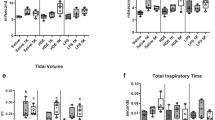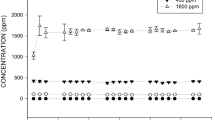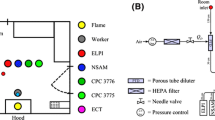Abstract
Groups of guinea pigs were exposed to the thermal decomposition products (TDP) released from acrylonitrile butadiene styrene (ABS), polypropylene-polyethylene copolymer (CP), polypropylene homopolymer (HP), or plasticized polyvinyl chloride (PVC). In single 50-min exposures to the TDP, guinea pigs exhibited sensory irritation, coughing, and airways constriction. Significant decreases in respiratory frequency (f) occurred during TDP exposure which were magnified during CO2 challenge conducted immediately post-exposure. For each resin, it was possible to demonstrate a linear relationship between the logarithm of heated mass and the percent decrease in f during CO2 challenge. From these relationships, the mass of each resin producing a 50% decrease in f during CO2 challenge (RD50 mass) was obtained. RD50 masses of 2744, 25.2, 16.0, and 6.7 g were obtained for ABS, CP, HP, and PVC, respectively. Thus, the relative potency of their TDP was PVC>CP ≈HP≫ ABS. Using the RD50 mass of each resin, guinea pigs were exposed to TDP for 50 min/day on 5 consecutive days. These repeated exposures also resulted in sensory irritation, coughing, and airways constriction. However, deaths occurred during exposures, and there was evidence of cumulative respiratory effects, and slower recoveries among survivors. Data obtained in guinea pigs were compared to a previous study with mice exposed to the TDP of the same four resins (Schaper et al. 1994). On the basis of heated mass, mice were 20–500 times more sensitive to the acute respiratory effects of TDP than guinea pigs. Thus, the exposure limits of 0.63, 0.11, 0.08, and 0.35 mg/m3 proposed by Schaper et al. (1994) on the basis of particulates released from ABS, CP, HP and PVC should prevent not only irritation, but also possible coughing, and airways constriction in workers.
Similar content being viewed by others
References
Alarie Y (1973) Sensory irritation by airborne chemicals. CRC Crit Rev Toxicol 2: 299–366.
Alarie Y (1981) Toxicological evaluation of airborne chemical irritants and allergens using reflex reactions. In: Leong BKJ (ed) Proceedings of the inhalation toxicology and technology symposium. Ann Arbor Science, Ann Arbor, MI, pp 207–231.
Alarie Y (1985) The toxicity of smoke from polymeric materials during thermal decomposition. Annu Rev Pharmacol Toxicol 25: 325–347
Alarie YC, Anderson RC (1979) Toxicologic and acute lethal hazard evaluation of thermal decomposition products of synthetic and natural polymers. Toxicol Appl Pharmacol 51: 341–362
Alarie Y, Schaper M (1988) Pulmonary performance in laboratory animals exposed to toxic agents and correlations with lung disease in humans. In: Loke J (ed) Pathophysiology and treatment of inhalation injuries. Marcel Dekker, New York, pp 67–122
Alarie Y, Ferguson J, Stock MF, Weyel DA, Schaper M (1987) Sensory and pulmonary irritation of methyl isocyanate in mice and possible cyanide-like effects of methyl isocyanate in guinea pigs. Environ Health Perspect 72: 159–167
Alarie Y, Iwasaki M, Schaper M (1990) Whole-body plethysmography in sedentary or exercise conditions to determine pulmonary toxicity, including hypersensitivity induced by airborne toxicants. J Am Coll Toxicol 9: 407–439.
Amdur MO, Mead J (1955) A method for studying the mechanical properties of the lungs of unanesthetized animals: application to the study of irritants. Proc. Third Natl. Air Pollut. Symp, Stanford Research Institute, Pasadena, CA, pp 150–159
American Conference of Governmental Industrial Hygienists (ACGIH) (1993) 1993–1994 Threshold limit values for chemical substances and physical agents and biological exposure indices. Cincinnati, OH
American Society for Testing and Materials (1984) Standard test method for estimating sensory irritancy of airborne chemicals. ASTM Designation E 981–84. Philadelphia, Pa
Anderson RC, Alarie Y (1980) Acute lethal effects of polyvinylchloride thermal decomposition products in normal and cannulated mice. Toxicol Appl Pharmacol: A3
Armitage P (1977) Statistical methods in medical research. Blackwell, London
Barrow C, Alarie Y, Stock MF (1976) Sensory irritation evoked by the thermal decomposition products of plasticized poly(vinyl chloride). Fire Materials 1: 147–153.
Barrow C, Alarie Y, Stock MF (1978) Sensory irritation and incapacitation evoked by thermal decomposition products of polymers and comparisons with known irritants. Arch Env Health 33: 79–88
Buckley LA, Jiang XZ, James RA, Morgan KT, Barrow CS (1984) Respiratory tract lesions induced by sensory irritants at the RD50 concentration. Toxicol Appl Pharmacol 74: 417–429
Burleigh-Flayer H, Wong KL, Alarie Y (1985) Evaluation of the pulmonary effects of HCl using CO2 challenges in guinea pigs. Fundam Appl Toxicol 5: 978–985
Ellakkani ME, Alarie YC, Weyel DA, Mazumdar S, Karol MH (1984) Pulmonary reactions to inhaled cotton dust: an animal model for byssinosis. Toxicol Appl Pharmacol 74: 267–284
Ferguson JS, Schaper M, Alarie Y (1987) Pulmonary effects of a polyisocyanate aerosol: hexamethylene diisocyanate trimer (HDIt) or Demosdur-N (DES-N). Toxicol Appl Pharmacol 89: 332–346
Froneberg B, Johnson PL, Landrigan PJ (1982) Respiratory illness caused by overheating of polyvinyl chloride. Br J Ind Med 29: 239–243
Hartzell GE, Grand AF, Switzer WG (1988) Modeling of toxicological effects of fire gases: VII. Studies on the evaluation of animal models in combustion toxicology. J Fire Sci 6: 411–431
Leithe W (1971) Special Topics. In: The analysis of air pollutants. Ann Arbor Science, Ann Arbor, MI, pp 213–214.
Malek D, Alarie Y (1989) Ergometer within a whole-body plethysmograph to evaluate performance of guinea pigs under toxic atmospheres. Toxicol Appl Pharmacol 101: 340–355.
Montgomery RR (1987) Polymers. In: Clayton GD, Clayton FE (eds) Patty’s industrial hygiene and toxicology, vol. 2C: Toxicology (3rd revised edition), chapter 54. Wiley, N.Y., pp 4209–4526
Purser DA, Wooley WD (1983) Biological studies of combustion atmospheres. J Fire Sci 1: 118–144
Rigby LJ (1981) The collection and identification of toxic volatiles from plastics under thermal stress. Ann Occup Hyg 24: 331–345
Schaper M (1993) Development of a database for sensory irritants and its use in establishing occupational exposure limits. Am Ind Hyg Assoc J 54: 488–544
Schaper M, Thompson RD, Alarie Y (1985) A method to classify airborne chemicals which alter the normal ventilatory response induced by CO2. Toxicol Appl Pharmacol 79: 332–341
Schaper M, Thompson RD, Detwiler-Okabayashi K (1994) Respiratory responses of mice exposed to thermal decomposition products from polymers heated at and above workplace processing temperatures. Am Ind Hyg Assoc J 55: 924–934
Society of the Plastics Industry (1993) Facts and Figures of the U.S. Plastics Industry. Washington, DC
U.S. Department of Labor. Occupational Safety and Health Administration (OSHA) (1989) Air contaminants — permissible exposure limits. (Title 29 Code of Federal Regulations, Part 1910.1000), Washington, DC
Vainio H, Pfaffli P, Zitting A (1980) Chemical hazards in the plastics industry. J Toxicol Environ Health 6: 1179–1186
Vijayaraghavan R, Schaper M, Thompson R, Stock MF, Alarie Y (1993) Characteristic modifications of the breathing pattern of mice to evaluate the effects of airborne chemicals on the respiratory tract. Arch Toxicol 67: 478–490
Vijayaraghavan R, Schaper M, Thompson R, Stock MF, Boylstein LA, Luo J, Alarie Y (1994) Computer assisted recognition and quantitation of the effects of airborne chemicals acting at different areas of the respiratory tract in mice. Arch Toxicol 68: 490–499
Wong KL, Alarie Y (1982) A method for repeated evaluation of pulmonary performance in unanesthetized unrestrained guinea pigs and its application to detect effects of sulfuric acid mist. Toxicol Appl Pharmacol 63: 72–90
Wong KL, Stock MF, Alarie Y (1983) Evaluation of the pulmonary toxicity of plasticized polyvinyl chloride thermal decomposition products in guinea pigs by repeated CO2 challenges. Toxicol Appl Pharmacol 70: 236–248
Zelenak JP, Alarie Y, Weyel DA (1982) Assessment of the cough reflex caused by inhalation of sodium lauryl sulfate and citric acid aerosols. Fundam Appl Toxicol 2: 177–180
Zitting A, Savolainen H (1980) Effects of single and repeated exposures to thermo-oxidative degradation products of poly(acryl-onitrile-butadiene-styrene) (ABS) on rat lung, liver, kidney, and brain. Arch Toxicol 46: 295–304
Author information
Authors and Affiliations
Rights and permissions
About this article
Cite this article
Detwiler-Okabayashi, K., Schaper, M. Evaluation of respiratory effects of thermal decomposition products following single and repeated exposures of guinea pigs. Arch Toxicol 69, 215–227 (1995). https://doi.org/10.1007/s002040050162
Received:
Accepted:
Issue Date:
DOI: https://doi.org/10.1007/s002040050162




